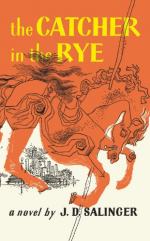|
|
The Catcher in the Rye Author/Context
Near the end of The Catcher in the Rye, Holden Caulfield imagines moving out West and pretending he's a deaf-mute. He wants to avoid "goddam stupid useless conversations with anybody. If anybody wanted to tell me something, they'd have to write it on a piece of paper and shove it over to me." Anyone who knows the barest details of J.D. Salinger's life will feel a little shiver of recognition when reading this quote. After a promising start as a story writer for magazines, and with four slim, though wildly popular, works of fiction published, the young Salinger left New York City and moved to a house in Cornish, New Hampshire. Within a year, he'd built a high fence around the yard, hung up a bunch of No Trespassing signs, stopped giving interviews, and has never since published another book or short story.
Up until his willful disappearance from the literary world in the mid-1960s, Salinger was one of America's most promising young writers. Born in 1919 in New York City, Salinger was a quiet boy, of whom a family friend said, "No one in the family knew where he was or what he was doing. He just showed up for meals." At age thirteen, when Salinger was asked in a school interview what subjects he was interested in, he replied drama and tropical fish. It's interesting to note that throughout his childhood, J.D. loved one of the professions Holden Caulfield hates most, acting. Salinger was not a distinguished student, and was kicked out of several schools, until he ended up at a military academy, where the discipline seemed to do him well. It was here that Salinger started to write, staying up late and writing stories by flashlight under the covers.
Salinger was persistent about writing, keeping at it even while his father sent him to Europe to learn the family business, the import-export trade. After his return, Salinger made his second try at college, having flunked out of New York University a few years earlier. Not too long into his stay at Ursinus College, Salinger dropped out again, in 1939. By this point Salinger was determined to turn all his energy to being a writer, and within a year he had his first story published, in the prestigious Story magazine.
Holden Caulfield, who stepped out of Salinger's pages and into the conservative world of President Eisenhower and Joseph McCarthy, is widely thought of as one of the first characters to capture the restless spirit of American youth. His appearance in 1951 cleared the way for other famous young American rebels: James Dean, Elvis, the main characters of films like "The Graduate" and "Dead Poets Society," and characters in books like A Separate Peace, The Basketball Diaries, and Rule of the Bone.
Holden's character was many years in the making. In 1941 Salinger had a story accepted, as was his dream, by the New Yorker, which also had a main character named Holden Caulfield. Holden's next appearance was in a 90-page novelette finished in 1946, which, Salinger was unhappy with and did not publish, even though it had been accepted by a publisher. By the time the Holden made it into the current version of Catcher, he'd evolved from a slightly pathetic character to one with a very American sort of attitude, which explains, at least in part, the way the book rocketed to success. It was made a Book-of-the-Month Club selection in 1951, noting that, "to anyone who has ever brought up a son, every page of Mr. Salinger's novel would be a source of wonder and delight--and concern" (French 49). The book has had a spectacular history. By 1997 it had sold 15 million copies in the USA, 60 million worldwide. It is on the banned book lists of many libraries and school districts.And it has been discovered in the breast pocket of several famous murderers, including the man who shot John Lennon.
As for the fate of Salinger, the few interviews he's given in the last thirty years have led more to speculation about his sanity than anything else. Gestures that might have suggested artistic integrity, such as when he sued for the right to declare that his books could not remain in print unless each edition featured only the text between two plain covers (no author bio or photograph, no praising blurbs), seem--after a series of lawsuits to keep his stories out of anthologies, to keep his life from biographies, to keep his work from making it to the screen--a bit like paranoia. Presently, Salinger is arguably less famous for his writing than he is for his personality, which periodically crashes forth in a new lawsuit or a bitter public comment.
When Holden Caulfield talks about his desire to be a deaf mute, he thinks that people will soon get tired of the effort it takes to communicate with him, "and then I'd be through with having conversations for the rest of my life. Everybody'd think I was just a poor deaf-mute bastard and they'd leave me alone." (198-99) citation form. If this is an autobiographical desire, it's not been realized. Salinger has people curious, especially because he's made it known that he's been writing steadily since he left the world of publication. As he toils away with his pen and paper in a little concrete bunker on his property, we can only imagine what writings, if any, he will choose to leave us when he dies.
Bibliography
Alexander, Paul. Salinger: A Biography. Los Angeles: Renaissance Books, 1999.
French, Warren. J.D. Salinger. Boston: Twayne, 1976.
Salinger, J.D. The Catcher in the Rye. New York: Bantam, 1964.




